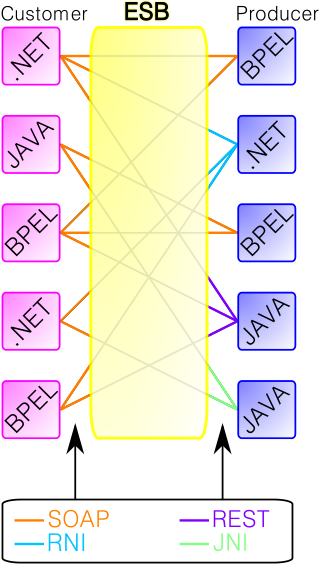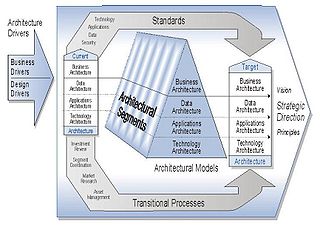Related Research Articles
In software engineering, multitier architecture is a client–server architecture in which presentation, application processing and data management functions are physically separated. The most widespread use of multitier architecture is the three-tier architecture.
Middleware in the context of distributed applications is software that provides services beyond those provided by the operating system to enable the various components of a distributed system to communicate and manage data. Middleware supports and simplifies complex distributed applications. It includes web servers, application servers, messaging and similar tools that support application development and delivery. Middleware is especially integral to modern information technology based on XML, SOAP, Web services, and service-oriented architecture.
Enterprise application integration (EAI) is the use of software and computer systems' architectural principles to integrate a set of enterprise computer applications.

An enterprise service bus (ESB) implements a communication system between mutually interacting software applications in a service-oriented architecture (SOA). It represents a software architecture for distributed computing, and is a special variant of the more general client-server model, wherein any application may behave as server or client. ESB promotes agility and flexibility with regard to high-level protocol communication between applications. Its primary use is in enterprise application integration (EAI) of heterogeneous and complex service landscapes.
Enterprise software, also known as enterprise application software (EAS), is computer software used to satisfy the needs of an organization rather than individual users. Such organizations include businesses, schools, interest-based user groups, clubs, charities, and governments. Enterprise software is an integral part of a (computer-based) information system; a collection of such software is called an enterprise system. These systems handle a number of operations in an organization to enhance the business and management reporting tasks. The systems must process the information at a relatively high speed and can be deployed across a variety of networks.
A mashup, in web development, is a web page or web application that uses content from more than one source to create a single new service displayed in a single graphical interface. For example, a user could combine the addresses and photographs of their library branches with a Google map to create a map mashup. The term implies easy, fast integration, frequently using open application programming interfaces and data sources to produce enriched results that were not necessarily the original reason for producing the raw source data. The term mashup originally comes from creating something by combining elements from two or more sources.
Business process interoperability (BPI) is a property referring to the ability of diverse business processes to work together, to so called "inter-operate". It is a state that exists when a business process can meet a specific objective automatically utilizing essential human labor only. Typically, BPI is present when a process conforms to standards that enable it to achieve its objective regardless of ownership, location, make, version or design of the computer systems used.

An information silo, or a group of such silos, is an insular management system in which one information system or subsystem is incapable of reciprocal operation with others that are, or should be, related. Thus information is not adequately shared but rather remains sequestered within each system or subsystem, figuratively trapped within a container like grain is trapped within a silo: there may be much of it, and it may be stacked quite high and freely available within those limits, but it has no effect outside those limits. Such data silos are proving to be an obstacle for businesses wishing to use data mining to make productive use of their data.
Data architecture consist of models, policies, rules, and standards that govern which data is collected and how it is stored, arranged, integrated, and put to use in data systems and in organizations. Data is usually one of several architecture domains that form the pillars of an enterprise architecture or solution architecture.

An enterprise architecture framework defines how to create and use an enterprise architecture. An architecture framework provides principles and practices for creating and using the architecture description of a system. It structures architects' thinking by dividing the architecture description into domains, layers, or views, and offers models - typically matrices and diagrams - for documenting each view. This allows for making systemic design decisions on all the components of the system and making long-term decisions around new design requirements, sustainability, and support.
Data integration involves combining data residing in different sources and providing users with a unified view of them. This process becomes significant in a variety of situations, which include both commercial and scientific domains. Data integration appears with increasing frequency as the volume and the need to share existing data explodes. It has become the focus of extensive theoretical work, and numerous open problems remain unsolved. Data integration encourages collaboration between internal as well as external users. The data being integrated must be received from a heterogeneous database system and transformed to a single coherent data store that provides synchronous data across a network of files for clients. A common use of data integration is in data mining when analyzing and extracting information from existing databases that can be useful for Business information.
An information server is an integrated software platform consisting of a set of core functional modules that enables organizations to integrate data from disparate sources and deliver trusted and complete information, at the time it is required and in the format it is needed. Similar to how an application server is a software engine that delivers applications to client computers, an information server delivers consistent information to consuming applications, business processes and portals.
System integration is defined in engineering as the process of bringing together the component sub-systems into one system and ensuring that the subsystems function together as a system, and in information technology as the process of linking together different computing systems and software applications physically or functionally, to act as a coordinated whole.
An integration competency center (ICC), sometimes referred to as an integration center of excellence (COE), is a shared service function providing methodical data integration, system integration, or enterprise application integration within organizations, particularly large corporations and public sector institutions.
In information systems, applications architecture or application architecture is one of several architecture domains that form the pillars of an enterprise architecture (EA).

An architecture domain in enterprise architecture is a broad view of an enterprise or system. It is a partial representation of a whole system that addresses several concerns of several stakeholders. It is a description that hides other views or facets of the system described. Business, data, application and technology architectures are recognized as the core domains in the most of proposed concepts concerned with the definition of enterprise architecture.

A view model or viewpoints framework in systems engineering, software engineering, and enterprise engineering is a framework which defines a coherent set of views to be used in the construction of a system architecture, software architecture, or enterprise architecture. A view is a representation of the whole system from the perspective of a related set of concerns.

NIST Enterprise Architecture Model is a late-1980s reference model for enterprise architecture. It defines an enterprise architecture by the interrelationship between an enterprise's business, information, and technology environments.
Data virtualization is an approach to data management that allows an application to retrieve and manipulate data without requiring technical details about the data, such as how it is formatted at source, or where it is physically located, and can provide a single customer view of the overall data.
Cloud-based integration is a form of systems integration business delivered as a cloud computing service that addresses data, process, service-oriented architecture (SOA) and application integration.
References
- ↑ "Disparate - definition of disparate by The Free Dictionary". Thefreedictionary.com. 2019-08-01. Retrieved 2022-05-13.